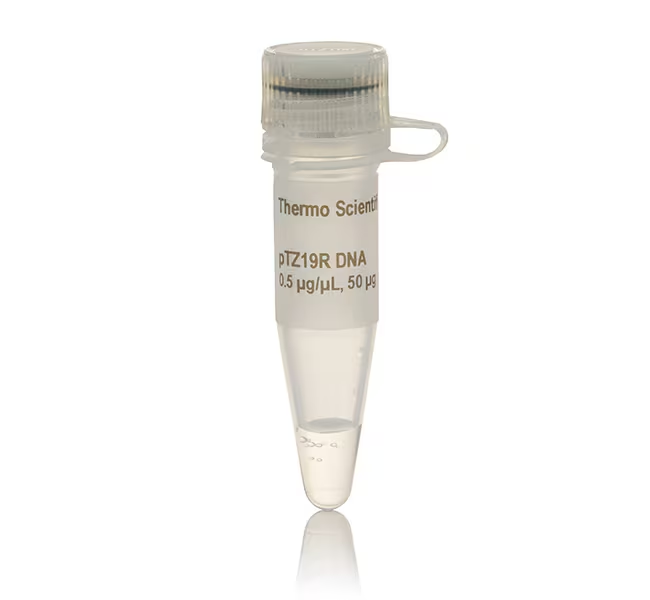
Thermo Scientific pTZ19R/U are small phagemids 2862 bp in length, constructed by inserting the DNA of phage f1 intergenic region (IG) into pUC19 and the T7 promoter sequence near to the MCS of pUC19. The phagemids differ in the orientation of the cloned f1 IG region. They are designed for DNA cloning, dideoxy DNA sequencing, in vitro mutagenesis, and in vitro transcription in one system. A host strain harboring these phagemids will produce single-stranded DNA if superinfected with the helper phage M13K07.
Highlights
• Isolated from E. coli (dam+, dcm+)
• More than 90% in the supercoiled form
• Isolated from E.coli (dam+, dcm-)
• For DNA sequence, sequence analysis and map creation see free online REviewer tool.
Applications
• Cloning
• Sequencing of insert DNAin vitro transcription
pTZ19R contents and usage notes - pTZ19R/U phagemids contain:
• The pMB1 replicon rep responsible for the replication of phagemid (source – plasmid pUC19)
• The bla gene, coding for beta-lactamase, that confers resistance to ampicillin (source – plasmid pUC19)
• The region of E. coli operon lac containing a CAP protein binding site, promoter Plac, lac repressor binding site and the 5’-terminal part of lacZ gene encoding the N-terminal fragment of beta-galactosidase (source – pUC19). This fragment allows blue/white screening of recombinant phagemids in the same way as described in the pUC18/19 section
• A T7 promoter inserted near to the MCS of pUC19, allowing in vitro synthesis of large amounts of specific RNA
• The phage f1 intergenic region carrying the sequences required in cis for initiation and termination of phage f1 DNA synthesis (+ and - strands) and for packaging DNA into bacteriophage particles
Synthesis of single-stranded (plus) DNA requires phage-encoded gene II, X, and V proteins. It is initiated at ori (+) and proceeds in the direction indicated. The conversion of plus DNA strands to double-stranded DNA does not require any of the phage genes. DNA synthesis is initiated by a 30-nucleotide RNA primer synthesized by the host’s RNA polymerase and starting at ori (-).
The map shows enzymes that cut pTZ19R DNA once. Enzymes produced by Thermo Scientific are shown in orange. The coordinates refer to the position of the first nucleotide in each recognition sequence.
The exact positions of the genetic elements are shown on the map (termination codons included). The bla gene nucleotides 2732-2664 (complementary strand) code for a signal peptide. The LacZ polypeptide corresponding to wt beta-galactosidase and essential for blue/white screening ends at nt position 458 (complementary strand). The remaining amino acids in the LacZ reading frame are encoded by f1 DNA. The indicated rep region is sufficient to promote replication. DNA replication initiates in the complementary DNA strand at position 1112 (± 1) and proceeds in the direction indicated. Phagemids and plasmids carrying the pMB1 and ColE1 replicons are incompatible with one another, but are fully compatible with those carrying p15A replicon (pACYC177, pACYC184). pMB1-derived plasmids can be amplified using chloramphenicol.
| Code | Description |
|---|---|
| SD0141 | Catalog Number: SD0141 |

